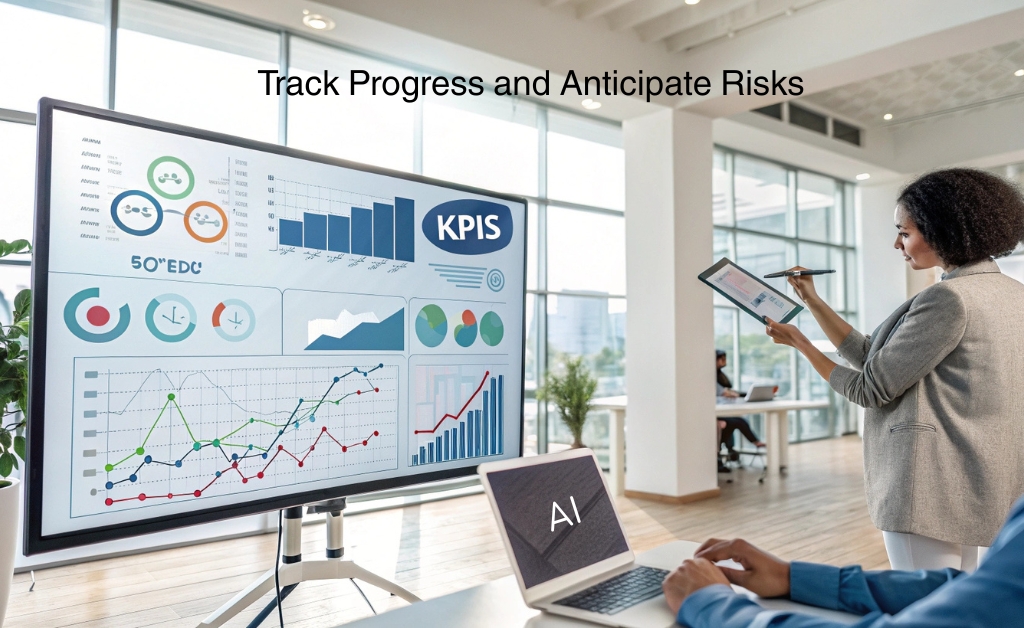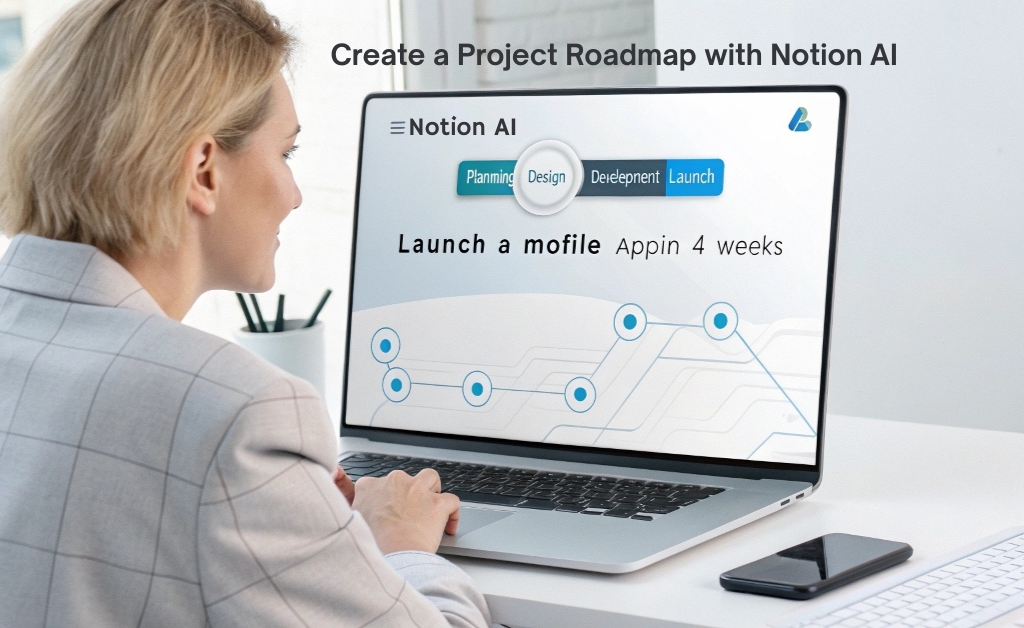Still relying on manual dashboards and gut instinct to manage your projects? AI is changing the game with predictive analytics, real-time KPI tracking and smart alerts, AI helps you track progress and anticipate risks before they happenin this post, we explore how AI-powered tools are transforming project tracking into a proactive data-driven strategy.
Why tracking project progress isn’t enough anymore
Let’s face it just “checking progress” once a week doesn’t cut it anymore projects evolve quickly, and relying on outdated dashboards or manual updates leaves you playing catch-upwhat if you could not only track performance but anticipate risks before they happen?
That’s the power of AI in project tracking it’s not just about charts and status updates it’s about using data to see ahead, like a project crystal ball
Key insight: AI-powered tracking doesn’t just report what happenedit predicts what might go wrong and helps you fix it before it does
Real-time KPI tracking: AI turns metrics into signals
AI transforms raw data into actionable insights instead of logging into five different tools, AI-powered platforms aggregate everything into one dynamic view more importantly, they interpret the data using machine learning models to detect deviations.
Let’s say your sprint velocity suddenly drops or task completion time increases AI flags itnot after the deadline is missed, but as soon as the trend starts this kind of early detection can save weeks of rework.
What KPIs can AI monitor in project management?
| Key performance indicator (KPI) | How AI enhances it |
|---|---|
| Task completion rate | flags patterns of delay, suggests bottleneck points |
| Budget variance | detects unusual expense trends based on past projects |
| Resource utilization | predicts over- or underuse of key personnel |
| Cycle time | identifies outliers affecting efficiency |
| Client feedback scores | uses sentiment analysis to track satisfaction trends |
Expert insight: A Stanford University study found that predictive AI in project management reduced timeline overruns by 35% in tech teams over a 12-month period
Predictive analysis: Seeing problems before they surface
This is where AI truly shines imagine having a system that scans every project update, every calendar eventand every communication thread and tells you, “This task will likely be late” or “This sprint has a 60% chance of exceeding its timeline”
AI tools use historical data, team behavior, and even external factors to generate probability scores for delay, budget drif or quality issues these predictive alerts allow project managers to pivot before things derail.
How predictive analysis actually works
- AI ingests historical and current data across tools (Asana – ClickUp – Slack – Jira- etc…)
- It applies machine learning models trained on thousands of past project patterns
- The system flags anomalies or risk signals and suggests preventive measures
This turns reactive project management into proactive decision-making
AI-powered alerts: Your smart early warning system
We all know the pain of discovering a critical task fell through the cracks—often after it’s too late AI helps by creating a watchtower over your projects you can set smart triggers based on your KPIsor let the AI generate them based on learned patterns.
- Low task velocity? Get notified before it slows down the entire sprint
- Too many overdue tasks? Receive suggestions to reassign workload
- Budget tracking off course? Get alerts before crossing thresholds
These alerts go straight to your inbox, Slack or even trigger automation workflows via platforms like Zapier or Make.com – a small example of how AI is quietly revolutionizing project management beyond basic automation.
Case study: Forecasting delays before they happen
Let’s look at a real-world example amid-size SaaS company used AI tracking to manage a 6-month product launch. Halfway through, the AI flagged a 70% risk of delay due to uneven resource allocation the team adjusted workloads based on the AI recommendations and met their deadline saving thousands in potential losses.
This wasn’t guesswork it was data-driven foresight in action
AI-based reporting: Say goodbye to manual status reports
Let’s be honest manual reporting is a productivity killer gathering updates, formatting slides and writing summaries steals hours from actual work AI flips the scriptby automating the reporting proces with the right tools, you can generate clean, insightful reports in minutes not hours.
Tools like Monday.com’s AI assistant and Zoho Analytics create live reports using real-time data from your tasks, sprints and KPIs no more copy-pasting from spreadsheets no more waiting on weekly updates
What AI-based reports can include
- Progress summaries: Clear visuals showing how close you are to milestones
- Workload analysis: Charts showing who’s overbooked or underutilized
- Risk heatmaps: Color-coded warnings for areas of concern
- Automated recommendations: Suggestions like “Shift Task X to John to balance capacity”
Pro tip: Customize AI-generated reports for different stakeholders executives want high-level trends, while team leads need tactical detail
Smarter dashboards with machine learning
Forget static dashboards that just sit there with AI, dashboards become interactive learning from your team’s behavior and surfacing insights you didn’t even know to look for.
Take Zoho Analytics for example. It uses natural language queries type “show me tasks delayed this month” and it builds the chart for you even better, it starts suggesting what to monitor based on your historical patterns
Dynamic dashboards vs traditional dashboards
| Feature | Traditional dashboards | AI-Powered dashboards |
|---|---|---|
| Data source updates | manual or scheduled sync | real-time, automatic |
| Customization | static widgets | dynamic filters + smart widgets |
| Recommendations | none | AI-suggested focus areas |
| Natural language query | not supported | fully supported |
The result? you spend less time building dashboards and more time acting on what they show
Anticipating long-term risks: AI’s strategic superpower
AI doesn’t just look at the next sprintit helps you forecast risks over the project lifecycle using cumulative data and machine learning, AI tools can identify hidden patterns like:
- Recurring bottlenecks caused by over-reliance on specific team members
- Scope creep based on changes in task descriptions over time
- Chronic underestimation of time for certain task categories
Instead of post-mortem reviews, you get ongoing performance diagnostics this allows you to make structural improvements not just quick fixes
Insight: Harvard Business Review highlights that teams using predictive project diagnostics experience 42% fewer critical incidents across long-term projects
AI tools that excel at tracking and risk management
Here’s a quick look at some of the best AI-powered tools you can use today to track performance and stay ahead of problems:
| Tool | Specialty | AI capabilities |
|---|---|---|
| Monday.com | project tracking & collaboration | smart alerts, deadline risk scoring, timeline forecasting |
| Zoho Analytics | custom dashboards & reporting | automated reports, anomaly detection, AI assistant for queries |
| Forecast App | resource management | predicts overcapacity, task delays, budget overruns |
| Wrike AI | task management at scale | smart prioritization, AI-based work predictions |
From firefighting to forecasting: The AI mindset shift
Most project managers operate in firefighter modeputting out one fire after another AI invites a mindset shift instead of reacting to problems, you start preempting them
You don’t wait for a sprint to fail to realize something’s offyou get an early heads-up you don’t run quarterly reviews to spot trends you see them unfold live, with suggestions attached.
AI turns project tracking from reactive to predictiv spotting risks, automating reporting, and optimizing performance before issues arise with tools like Monday.com and Zoho Analytics, you’re not just managing timelinesyou’re mastering them ready to track smarter, not harder dive deeper into our guides and stay ahead with AI-powered project management.



